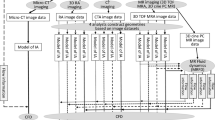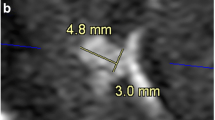Abstract
The purpose of our experimental study was to assess the accuracy and precision of CT angiography (CTA), MR angiography (MRA) and rotational digital subtraction angiography (DSA) for measuring the volume of an in vitro aneurysm model. A rigid model of the anterior cerebral circulation harbouring an anterior communicating aneurysm was connected to a pulsatile circuit. It was studied using unenhanced 3D time-of-flight MRA, contrast-enhanced CTA and rotational DSA angiography. The source images were then postprocessed on dedicated workstations to calculate the volume of the aneurysm. CTA was more accurate than MRA (P=0.0019). Rotational DSA was more accurate than CTA, although the difference did not reach statistical significance (P=0.1605), and significantly more accurate than MRA (P<0.00001). CTA was more precise than MRA (P=0.12), although this did not reach statistical significance. Rotational DSA can be part of the diagnosis, treatment planning and support endovascular treatment of intracranial aneurysms. The emerging endovascular treatment techniques which consist of using liquid polymers as implants to exclude aneurysms from arterial circulation would certainly benefit from this precise measurement of the volume of aneurysms.





Similar content being viewed by others
References
Sugiu K, Kinugasa K, Mandai S, Tokunaga K, Ohmoto T (1995) Direct thrombosis of experimental aneurysms with cellulose acetate polymer (CAP): technical aspects, angiographic follow up, and histological study. J Neurosurg 83: 531–538
Piotin M, Mandai S, Sugiu K, Gailloud P, Rüfenacht DA (2001) Endovascular treatment of cerebral aneurysms: an in vitro study with detachable platinum coils and tricellulose acetate polymer. Am J Roentgenol 176: 235–239
Nishi S, Taki W, Nakahara I, et al (1996) Embolization of cerebral aneurysms with a liquid embolus, EVAL mixture: report of three cases. Acta Neurochir (Wien) 138: 294–300
Murayama Y, Vinuela F, Tateshima S, Vinuela F Jr, Akiba Y (2000) Endovascular treatment of experimental aneurysms by use of a combination of liquid embolic agents and protective devices. AJNR 21: 1726–1735
Kinugasa K, Mandai S, Tsuchida S, et al (1994) Cellulose acetate polymer thrombosis for the emergency treatment of aneurysms: angiographic findings, clinical experience, and histopathological study. Neurosurgery 34: 694–701
Kinugasa K, Mandai S, Terai Y, Kamata I, et al (1992) Direct thrombosis of aneurysms with cellulose acetate polymer. Part II: Preliminary clinical experience. J Neurosurg 77: 501–507
Schwartz RB, Tice HM, Hooten SM, Hsu L, Stieg PE (1994) Evaluation of cerebral aneurysms with helical CT: correlation with conventional angiography and MR angiography. Radiology 192: 717–722
Vieco PT, Shuman WP, Alsofrom GF, Gross CE (1995) Detection of circle of Willis aneurysms in patients with acute subarachnoid hemorrhage: a comparison of CT angiography and digital subtraction angiography. Am J Roentgenol 165: 425–430
Villablanca JP, Martin N, Jahan R, et al (2000) Volume-rendered helical computerized tomography angiography in the detection and characterization of intracranial aneurysms. J Neurosurg 93: 254–264
Atlas SW, Sheppard L, Goldberg HI, Hurst RW, Listerud J, Flamm E (1997) Intracranial aneurysms: detection and characterization with MR angiography with use of an advanced postprocessing technique in a blinded-reader study. Radiology 203: 807–814
Tanoue S, Kiyosue H, Kenai H, Nakamura T, Yamashita M, Mori H (2000) Three-dimensional reconstructed images after rotational angiography in the evaluation of intracranial aneurysms: surgical correlation. Neurosurgery 47: 866–871
Anxionnat R, Bracard S, Ducrocq X,et al (2001) Intracranial aneurysms: clinical value of 3D digital subtraction angiography in the therapeutic decision and endovascular treatment. Radiology 218: 799–808
Bidaut LM, Laurent C, Piotin M, et al (1998) Second-generation three-dimensional reconstruction for rotational three-dimensional angiography. Acad Radiol 5: 836–849
Missler U, Hundt C, Wiesmann M, Mayer T, Bruckmann H (2000) Three-dimensional reconstructed rotational digital subtraction angiography in planning treatment of intracranial aneurysms. Eur Radiol 10: 564–568
Gailloud P, Pray JR, Muster M, Piotin M, Fasel JH, Rüfenacht DA (1997) An in vitro anatomic model of the human cerebral arteries with saccular arterial aneurysms. Surg Radiol Anat 19: 119–121
Bidaut LM, Pascual-Marqui R, Delavelle J, et al (1996) Three-to-five-dimensional multisensor imaging for the assessment of neurological (dys)function. J Digit Imaging 9: 185–198
Byrne JV, Sohn MJ, Molyneux AJ, Chir B (1999) Five-year experience in using coil embolization for ruptured intracranial aneurysms: outcomes and incidence of late rebleeding. J Neurosurg 90: 656–663
Cognard C, Weill A, Spelle L, et al (1999) Long-term angiographic follow-up of 169 intracranial berry aneurysms occluded with detachable coils. Radiology 212: 348–356
Kerber CW, Heilman CB, Zanetti PH (1989) Transparent elastic arterial models. I: A brief technical note. Biorheology 26: 1041–1049
Kerber CW, Imbesi SG, Knox K (1999) Flow dynamics in a lethal anterior communicating artery aneurysm. AJNR 20: 2000–2003
Steiger HJ, Liepsch DW, Poll A, Reulen HJ (1988) Hemodynamic stress in terminal saccular aneurysms: a laser-Doppler study. Heart Vessels 4: 162–169
Kallmes DF, Evans AJ, Woodcock RJ, et al (1996) Optimization of parameters for the detection of cerebral aneurysms: CT angiography of a model. Radiology 200: 403–405
Dix JE, Evans AJ, Kallmes DF, Sobel AH, Phillips CD (1997) Accuracy and precision of CT angiography in a model of carotid artery bifurcation stenosis. AJNR 18: 409–415
Wilcock DJ, Jaspan T, Worthington BS (1995) Problems and pitfalls of 3-D TOF magnetic resonance angiography of the intracranial circulation. Clin Radiol 50: 526–532
Pernicone JR, Siebert JE, Potchen EJ, Pera A, Dumoulin CL, Souza SP (1990) Three-dimensional phase-contrast MR angiography in the head and neck: preliminary report. AJNR 11: 457–466
Huston J 3rd, Rüfenacht DA, Ehman RL, Wiebers DO (1991) Intracranial aneurysms and vascular malformations: comparison of time-of-flight and phase-contrast MR angiography. Radiology 181: 721–730
Liu K, Rutt BK (1998) Sliding interleaved kY (SLINKY) acquisition: a novel 3D MRA technique with suppressed slab boundary artifact. J Magn Reson Imaging 8: 903–911
Author information
Authors and Affiliations
Corresponding author
Rights and permissions
About this article
Cite this article
Piotin, M., Gailloud, P., Bidaut, L. et al. CT angiography, MR angiography and rotational digital subtraction angiography for volumetric assessment of intracranial aneurysms. An experimental study. Neuroradiology 45, 404–409 (2003). https://doi.org/10.1007/s00234-002-0922-8
Received:
Accepted:
Published:
Issue Date:
DOI: https://doi.org/10.1007/s00234-002-0922-8




